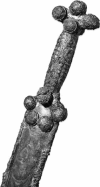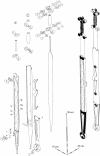Social ontologies
- PMID: 18292057
- PMCID: PMC2606704
- DOI: 10.1098/rstb.2008.0013
Social ontologies
Abstract
There is room for considerable cooperation between archaeology and neuroscience, but in order for this to happen we need to think about the interactions among brain-body-world, in which each of these three terms acts as cause and effect, without attributing a causally determinant position to any one. Consequently, I develop the term social ontology to look at how human capabilities of mind and body are brought about through an interaction with the material world. I look also at the key notion of plasticity to think about not only the malleable nature of human brains, but also the artefactual world. Using an example from the British Iron Age (approx. 750 BC-AD 43), I consider how new materials would put novel demands on the bodies and brains of people making, using and appreciating objects, focusing on an especially beautiful sword. In conclusion, I outline some possible areas of enquiry in which neuroscientists and archaeologists might collaborate.
Figures
References
-
- Collard M, Darvill T, Watts M. Ironworking in the Bronze Age? Evidence from a 10th century BC settlement at Hartshill Copse, Upper Bucklebury, West Berkshire. Proc. Prehist. Soc. 2006;72:367–436.
-
- Gell A. Clarendon Press; Oxford, UK: 1998. Art and agency: an anthropological theory.
-
- Gosden C. Material culture and long-term change. In: Tilley C, Keane W, Kuechler S, Rowlands M, Spyer P, editors. The sage handbook of material culture. Sage Publications; London, UK: 2005a. pp. 425–442.
-
- Gosden C. What do objects want? J. Archaeol. Method Theory. 2005b;12:193–211. doi:10.1007/s10816-005-6928-x - DOI
-
- Hingley R. The deposition of iron objects in Britain during the Later Prehistoric and Roman periods: contextual analysis and the significance of iron. Britannia. 2006;37:213–257.
Publication types
MeSH terms
LinkOut - more resources
Full Text Sources


